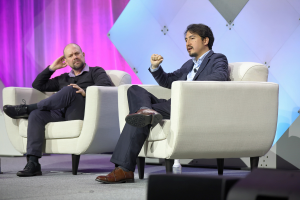
By Autumn Walden, Editor, AACRAO Connect, Content Strategy Manager, AACRAO
As higher education systems strive to create more equitable and efficient experiences for transfer learners, artificial intelligence is emerging as a transformative force. At the recent 110th AACRAO Annual Meeting, the Tuesday morning plenary session brought together two leading voices in the space—Dr. Daniel Knox of the National Association of Higher Education Systems and Dr. Zachary Pardos of UC Berkeley—for a deep dive into the future of AI in transfer advising and course articulation.
Moderated by Marc Booker, Vice Provost of Strategy at the University of Phoenix and co-lead for the upcoming Technology and Transfer 2025: A Learning Mobility Summit, the conversation centered around the persistent inefficiencies in credit mobility and the promising innovations that could finally break the cycle.
“The Chronicle put out discussion of the transfer maze, how systematic snags often block the path from community college to bachelor's degrees,” Knox noted, pointing to headlines and articles from the GAO and even a roundtable from the 1930s decrying the lack of credit portability. Yet despite decades of reform efforts—including SUNY’s systemwide articulation initiatives—progress has been incremental at best.
One striking statistic from the CCRC was shared: while most transfer models are designed as “two-plus-two” pathways, only 8% of students actually follow that linear route. The rest of student experiences need solutions tailored to their unique, often nonlinear journeys. “The problem though as you can see from this pie chart, if you wanted to pick another slice, the biggest one is actually enrollment breaks,” Knox explained.
Knox thanked AACRAO and its Executive Director Melanie Gottlieb for convening the plenary session, noting the value of bringing experts and practitioners together at a pivotal moment in the evolution of transfer policy.
Enter ATAIN: the AI Transfer and Articulation Infrastructure Network. With funding from College Futures and support from systems like SUNY, ATAIN is developing scalable, intelligent tools to automate and optimize credit evaluation. These tools, co-developed by Knox and Pardos, combine the power of AI algorithms with human insight to identify course equivalencies across massive networks of institutions.
Pardos, a computer scientist and director of Berkeley’s Computational Approaches to Human Learning Lab, provided a look under the hood. Using neural networks trained on over a decade of enrollment data, his lab models courses and student pathways to detect patterns that inform smarter articulation decisions. “Let's look into the brain of the AI and see how it conceptualizes each student,” Pardos said. “So we then looked at the course angle. What does a neural network concept of a course look like if we fed it these same data, 10 years of enrollment histories at the institution?”
One standout product from their collaboration is CourseWise, a platform that provides suggested articulations between institutions, similarity-based course mapping, and peer insights into how other colleges have evaluated specific credit. The interface allows users to search for matches, explore equivalency justifications, and view “articulated by” references showing where similar credits have already been accepted.
Importantly, the tools account for both the volume and nuance of transfer credit evaluation. In California alone, mapping community college courses to four-year institutions could involve over 36 million course pairs. Human review remains essential, but AI can triage these cases, saving time, surfacing new pathways, and reducing the burden on advisors and faculty.
Currently, 60 institutions are participating in the ATAIN pilot phase, using these tools and offering feedback that will shape ongoing development. Pardos also shared that a second cohort is forming, with applications opening soon for institutions interested in fully subsidized access to the platform and a collaborative space to rethink credit mobility.
Throughout the session, the speakers emphasized that AI must serve—not replace—human decision-makers. “One of the human factors that the literature has suggested and measured exists broadly outside of higher education administration is AI aversion,” Pardos clarified. “Especially with experts, if you're using AI to make suggestions, there can be more defensiveness to that than if the same suggestions were made by a human peer and suggestions can sometimes be dismissed.”
For those ready to reimagine transfer at scale, the future of AI and learning mobility is no longer theoretical—it’s algorithmic, collaborative, and already underway.